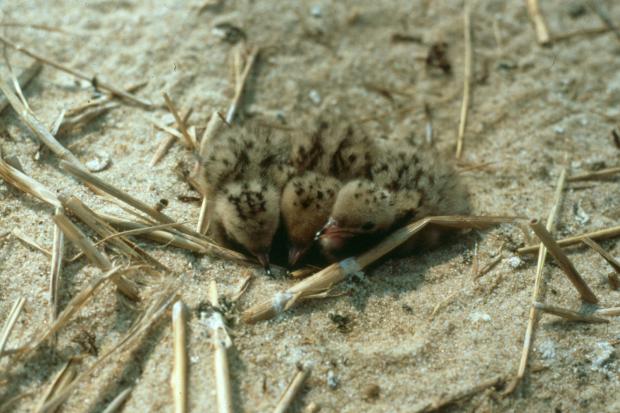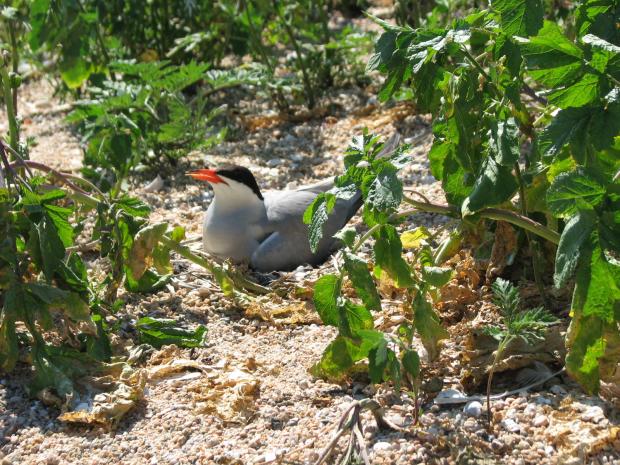The species you are most likely to see are the roseate tern, Sterna dougallii, and the common tern, Sterna hirundo. These migratory birds arrive in Massachusetts in April and May to nest, mostly on islands, and depart again for their wintering grounds (as far south as Argentina) in August and September. Their primary foods are juvenile fish such as herring, sand lance, and mummichog. Both tern species are long-lived, with the oldest wild birds reaching their mid- to upper-20s.
Colony life
Common and roseate terns are colonial nesters. A major benefit of nesting in a colony is group defense against intruders and predators. While common terns will nest in single-species colonies, roseates will not. In this part of the world, roseates always nest with common terns, which vigorously defend their nests and young against intruders—benefiting the much more timid roseates. This defense is necessary because eggs and young, although camouflaged with surroundings, are still vulnerable to being gobbled up by a predator or stepped on by a clumsy or inattentive human. Eggs are laid directly on the ground and chicks are "earth-bound" for about three or four weeks until they can fly.
A visit to a large colony of common and roseate terns is not easily forgotten. Intruders are mobbed by clouds of shrieking, divebombing, defecating terns. Humans (and some other animals) may also be pecked on the head and any exposed skin mercilessly by common terns. You would emerge spattered and weary, but hopefully with added respect for these tenacious birds.
Because these birds are so highly vulnerable, all tern colonies in Massachusetts are off-limits during the nesting season. Colonies may only be entered for approved research or management purposes. However, they can be enjoyed (much more peacefully) from a distance through binoculars or spotting scopes. You can also watch terns on our real-time Bird Island tern web camera. The camera is active from approximately mid-May through mid-July.
History
Until the 1880s, common and roseate terns were abundant in Massachusetts, with hundreds of thousands of pairs reportedly nesting at Muskeget Island (off Nantucket) alone. (See Nisbet, I.C.T. 1973. Terns in Massachusetts: recent numbers and historical changes. Bird-banding 44: 27-55.). Like many other bird species, however, terns were victims of their own loveliness. They were hunted nearly to extinction along the Atlantic Coast for their plumes, which were used to adorn hats. In Massachusetts, large numbers of terns survived at just a few locations.
The conservation movement swelled during that time period—in great part due to outrage over the hunting of birds for their feathers. Consequently, both local and national legislation was enacted that provided legal protection for many birds. In Massachusetts, as in other places, terns responded to enhanced protection and populations partially recovered.
Starting in the 1930s, gulls (especially great black-backed and herring gulls) gained a footing in the Commonwealth and their populations exploded, aided by food from garbage dumps and discards from the fishing industry. Gulls overtook common and roseate terns' preferred nesting sites—the offshore islands that are relatively secure from predators—and tern populations plummeted. Gull populations continued to grow through at least the 1970s. Closure of dumps and better management of fisheries waste have probably been major factors that checked the growth of gull populations; gull populations have declined substantially since their peak.
Contact
Online
Phone
Open M–F, 8 a.m.–4 p.m. (closed noon–12:30 for lunch)
North/Central/Western Massachusetts
Southeastern Massachusetts/Cape & Islands

